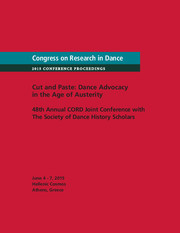No CrossRef data available.
Article contents
Musical Tastes in Popular Dance Practices
Published online by Cambridge University Press: 05 December 2013
Abstract
This paper explores the relationship between musical tastes and dance practices in popular dance practices. It is based on ideas that emerged from a multisited ethnography involving the participation in and observation of the practices of breaking, as well as interviews with individual b-boys and b-girls, who often traveled between cities as part of their practices. Although there were many interesting and contradictory observations and participant responses provided by this multigenerational, multicultural scene, one theme emerged as central.
- Type
- Research Article
- Information
- Copyright
- Copyright © Mary Fogarty 2012


